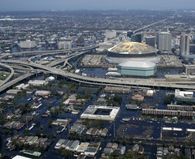|
COMPARING
RELIEF EFFORTS – TSUNAMI VS KATRINA
Ramaa
E-mail
: behindw@behindwoods.com |
 |
 |
Any
natural calamity evokes a wave of sympathy
for the victims. The loss suffered could apparently
seem to be similar but the intensity and the
impact could be vastly different. The familiar
symptoms like loss of lives, homes, belongings,
sources of livelihood and access to medical
attention present great challenges for relief
workers. The psychological impact of the unfortunate
incident is more intangible.
|
 |
 |
The
role of relief workers or disaster management
professionals is onerous. They shoulder
the burden of expectation of battered
souls. They should provide appropriate
and timely relief. The method of delivery
of relief varies with the unique circumstances.
In this context, this article analyzes
the relief efforts undertaken during
the two major calamities, which shook
the world recently- the |
giant
tsunami of December 2004 and Hurricane
Katrina of September 2005. Both are
regular natural phenomena but this time
round they struck with such unprecedented
intensity that the entire world was
left gaping. The tsunami hit largely
under-developed pockets of the world
like Indonesia, Sri Lanka and southern
India. International aid flowed in freely
as these nations called out for help.
Men and material were mobilized on an
emergency mode so as to bring |
 |
 |
succour
to thousands of victims. While these nationswere
found wanting in systems, which could
respond smoothly to calamities, the sheer
sense of fortitude of the victims complemented
the humanistic approach of the relief
workers. The giant hurricane Katrina and
its successor Rita hit the Louisiana and
Texas coast of the USA. The loss has been
estimated to run into thousands of billions
of dollars. The world’s |
|
richest
country stood exposed about its ugly underbelly
of skewed development and misplaced priorities.
Its unsafe choices with the environment have
resulted in compounding the woes of the
people in these areas. They remain the marginalized
and faceless section of American society for
whom the government would not go the extra mile
so as to bring in quick relief. The scenes of
people huddled in the cold amongst surging waters
holding on to anything they perceived precious
or the long traffic-choked highways or the traumatized
outbursts of the victims remained headline news
for about a week. We do not know what became
of them afterwards. Thus, they were conveniently
forgotten partly because there has been a subtle
agenda in the media not to project the US in
bad light. Leaving aside such politics, there
should be coordinated efforts to rehabilitate
the hurricane victims. Most of them are poor
in a wealthy nation which makes their plight
pitiable. Let a chorus rise for them. |
 |
|
|
|
|